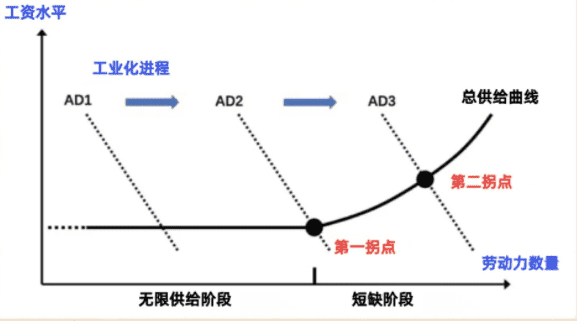What is the Lewis Turning Point?
What does the Lewis Turning Point mean?
The Lewis Turning Point is an important economic theory proposed by economist Arthur Lewis, describing the process in developing countries where labor shifts from the agricultural sector to the industrial sector during industrialization, and how this shift affects economic growth and wage levels.
Lewis proposed his "dual economy" development model. He believed that economic development is a process of expansion of the modern industrial sector relative to the traditional agricultural sector. This expansion continues until all surplus labor in the traditional agricultural sector is fully transferred, leading to the emergence of an integrated urban-rural labor market. At this point, the dual economy dissolves completely, and the economy transitions into a single-sector economy.
Lewis's "dual economy" development model can be divided into two stages:
-
Unlimited Labor Supply Stage: During this phase, there is a labor surplus, meaning workers compete for jobs, and wages do not need to rise to attract labor.
-
Labor Shortage Stage: The surplus labor in the traditional agricultural sector is fully absorbed by the modern industrial sector, leading to a situation where employers compete for workers, and wages must increase to attract suitable employees.
Lewis’s First and Second Turning Points
Based on the dual economic structure, Lewis proposed two turning points:
-
First Lewis Turning Point:
This occurs when the dual economy transitions from the first stage (unlimited labor supply) to the second stage (labor shortage). At this point, the labor supply curve begins to slope upward, and wages start to rise steadily. The commonly referred-to "Lewis Turning Point" usually means this first turning point. -
Second Lewis Turning Point:
As industrialization progresses further, the surplus rural labor is almost entirely absorbed. The demand for labor in the industrial sector begins to exceed supply, leading to a significant increase in wages. This marks the arrival of the "second turning point."

China’s Lewis Turning Point
Combining the concept of the "demographic dividend," we can conclude:
-
The First Lewis Turning Point marks the beginning of the decline in the demographic dividend.
-
The Second Lewis Turning Point signifies the complete exhaustion of the demographic dividend.
So, when did China reach its first and second Lewis Turning Points?
There is no consensus on the first turning point. Some argue that it occurred around 2004, as labor-intensive industries in coastal regions began experiencing labor shortages ("migrant worker shortages"), and wages for migrant workers rose significantly. However, others suggest that the 2004 phenomenon was due to agricultural tax reductions, which reduced the incentive for rural workers to migrate to cities.
Similarly, some believe the first turning point was around 2009, when severe labor shortages appeared in both coastal and inland regions. However, the financial crisis later reduced export demand, causing many migrant workers to return home.
As for the Second Lewis Turning Point, it is generally believed that more time is needed. Even though the demographic dividend is declining, the second turning point can only be confirmed when urban and rural labor markets achieve near-equal opportunities in employment, wages, working conditions, and social security. Currently, there is still a significant gap.
















